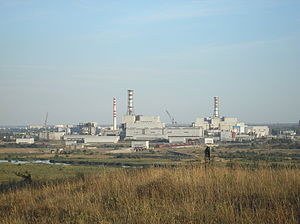This article needs additional citations for verification. (July 2023) |
| Kursk Nuclear Power Plant | |
|---|---|
 Kursk I RBMK with the incomplete blocks 5 and 6 in the foreground in 2010 | |
 | |
| Official name |
|
| Country | Russia |
| Coordinates | 51°40′35″N 35°36′23″E / 51.67639°N 35.60639°E |
| Status | Operational |
| Construction began | 1 June 1972 |
| Commission date | 12 October 1977 |
| Owner | Rosatom |
| Operator | Rosenergoatom |
| Nuclear power station | |
| Reactor type | RBMK-1000 |
| Power generation | |
| Units operational | 2 × 1,000 MW |
| Units decommissioned | 2 × 1,000 MW |
| Nameplate capacity | 2,000 MW |
| External links | |
| Website | Kursk NPP |
| Commons | Related media on Commons |
The Kursk Nuclear Power Plant[a] is one of the three biggest nuclear power plants (NPPs) in Russia and one of the four biggest electricity producers in the country. It is located on the bank of the Seym River about 40 kilometers west of the city of Kursk, midway between it and the town of Lgov, in western Russia. The nearby city of Kurchatov was founded when construction of the plant began. The plant feeds the grid for Kursk Oblast and 19 other regions. As of 2024, the site houses two active reactors and two decommissioned older units. It also houses the partially built Kursk 5 and Kursk 6 units which had construction halted, and two new VVER designs (Kursk II-1 and Kursk II-2) are under construction.
The International Atomic Energy Agency's Director General Rafael Grossi urged both Russia and Ukraine to exercise "maximum restraint" to avoid an accident at the plant during the August 2024 Kursk Oblast incursion following reports of "significant military activity" near the facility.[1]
Cite error: There are <ref group=lower-alpha> tags or {{efn}} templates on this page, but the references will not show without a {{reflist|group=lower-alpha}} template or {{notelist}} template (see the help page).
- ^ "UN urges restraint to avoid Russia nuclear plant disaster". RTÉ News. 9 August 2024. Retrieved 9 August 2024.